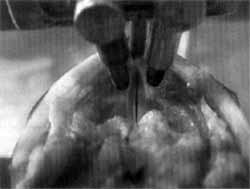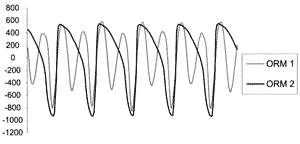INTRODUCTION After the anatomical-histologic modeling of vocal folds proposed by Hirano 9 and the mechanical-functional modeling proposed by Flanagan and Ishizaka¹°, the study of physiology of laryngeal vibration based on the harmonic functioning mode was the objective of a series of studies. However, the analysis of vocal sign showed the existence of complex phenomena that may not be explained by such models, such as amplitude and frequency modulations, presence of sub-harmonics and bifurcations 7,16. These phenomena were described as being the result of the interaction of aerodynamic systems of the larynx. However, analyzed data were obtained indirectly, because they came from the vocal sign, which was in itself a result of the interaction of mechanical and aerodynamic phenomena. Therefore, this is the reason why the study of these phenomena with equipment capable of detecting vibrations of each separate fold attracted attention and interest.
The purpose of our study was to directly analyze the vibratory mechanics of the vocal folds under normal and asymmetric conditions, using a device that is capable of analyzing horizontal and vertical components of laryngeal vibration.
Different analysis means used so far did not meet our needs.
Microphone sign and electroglottography (ECG) enable the analysis of the global acoustic (variation of vibration pressure) and mechanical (contact between the vocal folds) phenomena, but they do not provide information about the isolated chord movement².
Videostroboscopy creates artificially slowed images of the vibration of the vocal folds but it does not enable direct analysis of action. High-speed videography enables acquisition of a large number of images (8,000 images/sec); however, besides the high cost, the difficulty to interpret the images reduces its importance as a device to analyze vocal sign 1,8,10.
Videokymography is a videographic method of chord movements that use a frequency of 7812.45 Hz; 12,13. It provides data about glottic opening but not about vibration, because similarly to all videographic methods it measures only the horizontal component of the glottic movement.
The one procedure described in the literature that is capable of measuring the vertical component of vibration was demonstrated by Nakagawa et al.¹¹. The procedure consists of applying small radiopaque plates to the surface of the vocal folds of dog larynxes sectioned for the study and follow up the chord movement by x-ray and stroboscopy. However, the technique is unlikely to have clinical application because it is very aggressive and requires the use of exogenous materials on the laryngeal surface, which could modify the mechanical characteristics of the folds, changing its measures.
Taking into account these difficulties, we assembled a laser mechanism based on optometry, optoretlexometer (ORM) ¹², that is capable of measuring independently the vocal folds, providing information about horizontal and vertical components. ORM enables remote analysis of a target movement (vocal folds). The intensity of the reflected beam is inversely proportional to the distance between the origin of the beam and the target. The collected and analyzed sign provides information about displacement and deformation of the target. By varying the angle and the place on where the beam touches the vocal folds, we may analyze the horizontal or vertical components of vibration¹³.
MATERIAL AND METHODThe present study was conducted using sectioned swine larynxes put into vibration in a bench of experimental analysis 5. The bench has a 320-watt turbine (running at 2,800 rounds per minute), capable of generating air output of up to 101/s. A computer ensures the control of measurable parameters of the experiment: air output, temperature and hygrometry. Air is humidified and warmed at 37° C and pushed towards the trachea by a intubation probe. The treatment of vocal sign is conducted by a software specifically created for the experiment.
A micropositioner is placed vertically in the ventricular region, in its posterior third. This device ensures that the necessary pressure for the vocal folds to adduct will be made, modifying the tension of the vocal muscle (body-cover theory) 9, enabling the creation of controllable asymmetric situations. The movement is done by a microengine controlled by computer, with a precision of 10° of mm. All devices have force catchers that constantly inform the pressure that is being made on the laryngeal tissue.
Two ORM were used to collect data about the vibration of vocal folds. Each ORM pointed to the mucosa of the superior part of each vocal fold (Photo 1).
Measures were made in seven larynxes of recently slaughtered pigs. We recorded waves of ORM, with different air outputs, and considered the measures that had fewer artifacts.
The experimental conditions followed the protocol below:
1. Measure of symmetric position of vocal folds obtained with balanced pressure of both micropositioners;
2. Measure of asymmetric positions with moderate pressure made by the micropositioners;
3. Measure of severe asymmetry, producing unstable acoustic sign.
The signs obtained for each vocal fold were compared and analyzed.

Photo 1. Positioning of two ORM in dissected pig larynx.
The present study showed that in situations of tension, opposite to a symmetric situation, the onset of vibration of vocal folds does not take place simultaneously. After a transient asynchrony both signs become synchronous and in phase. This transient aspect was proportional to the degree of asymmetry imposed by the system (Graphs 1A and 1B).
In conditions of extreme asymmetry, we observed aberrant vibratory strategies. During some periods, the vocal folds presented episodes of asynchrony and delay, through which one fold vibrated at a frequency that was exactly the double of the other (doubling period) (Graph 2).
DISCUSSIONNon-linear phenomena, such as modulations, duplication of periods and bifurcations that are randomly oriented, have generated a large number of studies 3, 4,5,6,7,15. These phenomena may find possible explanations in the interaction between both vocal folds 5. However, this hypothesis could not be checked so far because of lack of direct methods to analyze the interaction.
Under conditions of asymmetry found in our experiment, vocal folds started vibrating at their own frequency, dictated by their different physical characteristics (asymmetry of tension). However, intensity of interaction among them suddenly synchronized them. The final outcome of this interactivity was a sign marked by significant non-linearity.
The experiment conducted under poor asymmetry conditions may be compared to a physiological situation, because vocal folds do not have exactly the same physical characteristics. In this case, asymmetry is so mild that synchronization takes place almost immediately.

Graph 1. Onset of vibratory movement under normal conditions (graph 1A) and under conditions of marked asymmetry (graph 1B). Note the delay in onset of synchronization (black arrow).

Graph 2. "Doubling period" under conditions of extreme asymmetry.
If asymmetry increases, interaction forces are not enough for an immediate synchronization of vocal folds, which is translated by delay between the onset of vibration and synchronization of vocal folds. The duration of this period is related to degree of asymmetry.
In cases of significant asymmetry of tension, we found the presence of a vibration phenomenon characterized by a vocal fold that vibrates exactly at the double of the other (doubling period). This unheard-of phenomenon shows the complexity of the interaction mechanism that makes two bodies with completely different physical characteristics vibrate synchronically.
Thanks to this new way of measuring isolated vibration, we noticed the existence of complex phenomena such as modulation of frequency, doubling periods and delay between two united oscillating systems. The harmonic functioning mode is not enough to describe the complexity of laryngeal vibration.
CONCLUSIONFor the first time ever, vibration periods of each isolated vocal fold were completely studied. The trend of the literature points to the study of non-linearity of glottic movement and this fact has been highlighted by demonstrating aberrant vibration strategies, such as doubling period. In view of the possibility of measuring each isolated vocal fold, a new line of study about the role of glottic interaction in vocal production has been brought to light.
REFERENCES1. BAER, T.; LOFQVIST, A.; Mc GARR, N. S. - Laryngeal vibrations: a comparison between high-speed filming and glottographics techniques. J. Acoust. Soc. Am., 73: 1304-1308, 1983.
2. BEHRMAN, A.; AGRESTI, C. J.; BLUNSTEIN, E.; LEE, N. Microphone and electroglottographic data from dysphonic patients: type 1, 2 and 3 signals. J. Voice, 12: 249-260, 1998.
3. BERRY, D. A.; HERZEL, H.; TITZE, I. R.; STORY, B. H. Bifurcations in excised larynx experiments. J. Voice, 10: 129138, 1996.
4. BERRY, D. A.; HERZEL, H.; TITZE, I. R.; KRISCHER, K. Interpretation of biomechanical simulations of normal and chaotic vocal fold oscillations with empirical engine functions. J. Acoust. Soc. Am., 95: 3595-3604, 1994.
5. GIOVANNI, A.; OUAKININE, M.; GUELFUCCI, B.; TRIGLM, J. M. - Nonlinear behavior of vocal fold vibration: the role of coupling between the vocal folds. J. Voice, 13: 465-476, 1999.
6. GIOVANNI, A.; OUAKININE, M.; TRIGLIA, J. M. Determination of largest Lyapunov exponents of vocal signal: application to unilateral laryngeal paralysis. J. Voice, 13: 341354, 1999.
7. HERZEL, H.; BERRY, D.; TITZE, I. R.; SALEH, M. -Analysis of vocal disorders with methods from non-linear dynamics. J Speech Hear Res., 37: 1008-1019, 1994.
8. HESS, M. M.; HERZEL, H.; KOSTER, O.; SCHEURICH, F.; GROSS, M. - Endoscopic imaging of vocal cord vibrations. Digital high-speed recording with various systems. HNO, 44: 685-693, 1996.
9. HIRANO, M.; KAKITA, Y - Cover body theory of vocal fold vibration. In: Danlloff R, ed. Speech Science. San Diego: College-Hills Press, 1-46, 1985.
10. ISHIZAKA, K.; FLANAGAN, J. L. - Synthesis of voiced sounds from a two-mass model. Bell Syst. Tech. J. 51: 1233-1268, 1972.
11. KUROKAWA, H. - High-speed cinemtographic analysis of subglottal mucosal vibration during experimental induced phonation in excised larynges. Nippon jibiinkoko Gakkai Kaiho. 95: 1151-1163, 1992.
12. NAKAGAWA, H.; FUKUDA, H.; KAWAIDA, M.; SHIOTANI, A.; KANSAKI, J. Lubrification mechanism of the larynx during phonation: an experimental in excised canine larynges. Folia Phoniatr Logop., 50: 183-194, 1998.
13. OUAKININE, M.; GARREL, R.; NAZARIAN, B.; GIOVANNI, A. - Separate detection of the vibration of each vocal cord using a new optoelectronic system. Submetido à publicação no IEEE.
14. SCHUTTE, H. K.; SVEC, J. G.; SRAM, F. - First results of clinical application of videokymography. Laryngoscope, 108: 1206-1210, 1998.
15. SVEC, J. G.; SCHUTTE, H. K. - Videokymography: high speed line scanning of vocal fold vibration J. Voice. 10: 201-205, 1996.
16. TITZE, I. R.; BAKEN, R. J.; HERZEL, H. - Evidences of chaos in vocal fold vibration. In Titze IR, ed. Vocal fold physiology: frontiers in basic science. San Diego, CA: Singular Publishing Group, 1993: 143-188.
* Master studies under course, D. E. A. Langage et Parole, Mention Pathologie, Laboratoire de Phono Audiologie Clinique, CHU La Timone (Marseilles, France)
** Head Engineer of Laboratoire de Phono-Audiologie Clinique, CHU La Timone (Marseilles, France).
*** Professor of the Department of Otorhinolaryngology and Head and Neck Surgery at Universite de La Mediterranee, CHU La Timor: (Marseilles, France).
Study presented 35° Congresso Brasileiro de Otorrinolaringologia, which was awarded a special citation.
Article submitted on August 15, 2000. Article accepted on October 20, 2000.


